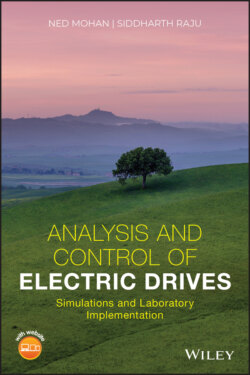Читать книгу Analysis and Control of Electric Drives - Ned Mohan - Страница 51
Solution
ОглавлениеThe electrical equivalent circuit is shown in Fig. 2-13a. The inertia is represented by a capacitor of 5 mF, and the friction by a resistance R = 1/(0.5 × 10−3) = 2000 Ω. The linear acceleration is 100/4 = 25 rad/s2, which in the equivalent electrical circuit corresponds to dv/dt = 25 V/s. Therefore, during the acceleration period, v(t) = 25t. Thus, the capacitor current during the linear acceleration interval is
(2-34a)
and the current through the resistor is
(2-34b)
Therefore,
(2-34c)
Beyond the acceleration stage, the electromagnetic torque is required only to overcome friction, which equals 50 × 10−3 Nm, as plotted in Fig. 2-13b.
Fig. 2-12 Electrical analogy: (a) shaft of finite stiffness and (b) shaft of infinite stiffness.
Fig. 2-13 (a) Electrical equivalent and (b) torque and speed variation.
